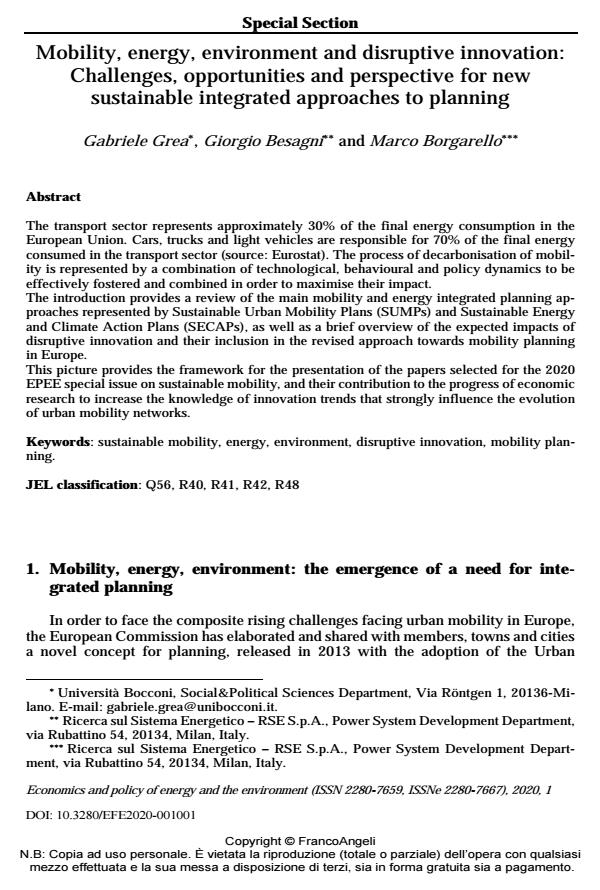Mobility, energy, environment and disruptive innovation: Challenges, opportunities and perspective for new sustainable integrated approaches to planning
Journal title ECONOMICS AND POLICY OF ENERGY AND THE ENVIRONMENT
Author/s Gabriele Grea, Giorgio Besagni, Marco Borgarello
Publishing Year 2020 Issue 2020/1
Language English Pages 8 P. 5-12 File size 115 KB
DOI 10.3280/EFE2020-001001
DOI is like a bar code for intellectual property: to have more infomation
click here
Below, you can see the article first page
If you want to buy this article in PDF format, you can do it, following the instructions to buy download credits

FrancoAngeli is member of Publishers International Linking Association, Inc (PILA), a not-for-profit association which run the CrossRef service enabling links to and from online scholarly content.
The transport sector represents approximately 30% of the final energy consumption in the Eu-ropean Union. Cars, trucks and light vehicles are responsible for 70% of the final energy con-sumed in the transport sector (source: Eurostat). The process of decarbonisation of mobility is represented by a combination of technological, behavioural and policy dynamics to be effec-tively fostered and combined in order to maximise their impact. The introduction provides a review of the main mobility and energy integrated planning ap-proaches represented by Sustainable Urban Mobility Plans (SUMPs) and Sustainable Energy and Climate Action Plans (SECAPs), as well as a brief overview of the expected impacts of disruptive innovation and their inclusion in the revised approach towards mobility planning in Europe. This picture provides the framework for the presentation of the papers selected for the 2020 EPEE special issue on sustainable mobility, and their contribution to the progress of economic research to increase the knowledge of innovation trends that strongly influence the evolution of urban mobility networks.
Keywords: Sustainable mobility, energy, environment, disruptive innovation, mobility plan-ning.
Jel codes: Q56, R40, R41, R42, R48
- Innovation and practice of operation, profit, and management of enterprises from the perspective of economic goals of carbon peak and neutralization Yaochong Fan, in International Journal of Low-Carbon Technologies /2024 pp.1942
DOI: 10.1093/ijlct/ctae106
Gabriele Grea, Giorgio Besagni, Marco Borgarello, Mobility, energy, environment and disruptive innovation: Challenges, opportunities and perspective for new sustainable integrated approaches to planning in "ECONOMICS AND POLICY OF ENERGY AND THE ENVIRONMENT" 1/2020, pp 5-12, DOI: 10.3280/EFE2020-001001